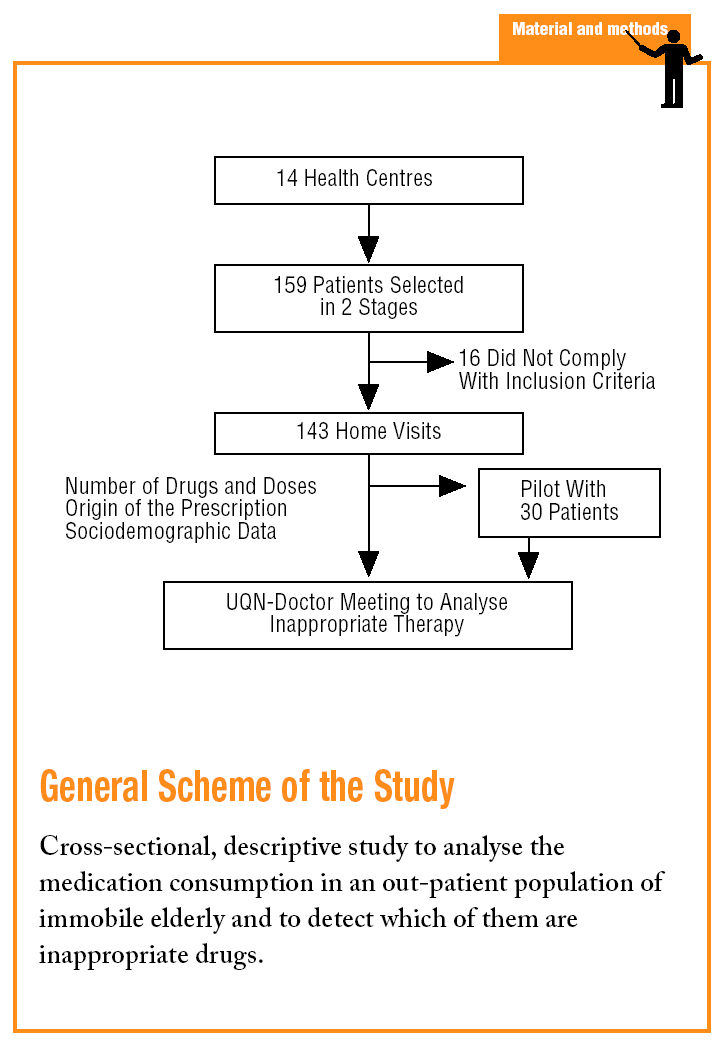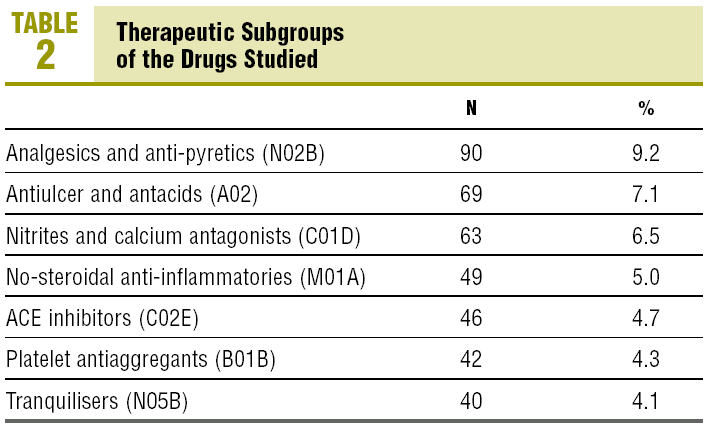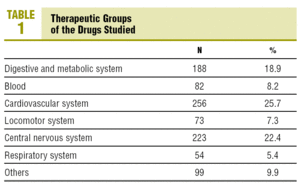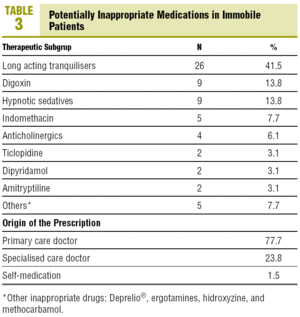Introduction
As age advances, the risk of having multiple illnesses can lead to increased immobility, and to a parallel increase in the number of drugs used.1 Very often, the elderly use drugs incorrectly, which causes great problems: frequent and sometimes serious adverse effects, therapeutic non-compliance, duplication of doses and drugs, absence of treatment in diseases that can be improved with suitable drugs, drug interactions, use of inappropriate medication, etc.2 The consequences of these problems are not insignificant: increased morbility,2 more frequent hospitalisation,3 and functional disability,4 poorer quality of life,4,5 and probably higher mortality.6
On many occasions, these effects are the result of inappropriate prescribing. Given that the majority of prescriptions come from the family doctor, the need to improve its quality is fundamental and unavoidable for the family doctor. For this reason, we have designed and carried out this study, with the objective of ascertaining and analysing the medications taken by the elderly immobile population, as well as the number of potentially inappropriate medications (PIM).
General Scheme of the Study. Cross-sectional, descriptive study to analyse the medication consumption in an out-patient population of immobile elderly and to detect which of them are inappropriate drugs.
Methods
Design
Cross-sectional descriptive study.
Setting
The study was carried out in 14 rural health settings (3 health centres, 9 clinics and 2 auxiliary clinics), within the Guadalquivir Health District, Cordoba, Spain.
Study Population
The inclusion criteria were: to be greater than 64 years, not institutionalised and to be immobile (defined as incapacity to move around their environment and to carry out activities of daily living).7
The sample was selected by means of successive sampling: firstly, it was stratified by doctor of the participants involved, and then systematic sampling was used based on the lists of immobile patients in the participating centres.
The calculation of the sample size was carried out according to the results of a previously carried out pilot study on 30 patients: for an α error =0.05, a precision of 5% and a q=p=50%, and assuming losses of 10%, the sample size had to be 160 patients.
Principal Measurements
Data were collected by a university qualified nurse (UQN) assigned to the home care programme.
The patients were informed of the objective and the aims of the study, emphasising that participation was voluntary and by informed verbal consent of the patient or their principal carer. Afterwards, permission was requested to review the medicine cabinet in the presence of the participant.
The number of medications in the home medicine cabinet was noted, marking those that were currently being used by the immobile patient and their doses, as well as demographic data. They were asked about the origin of the prescription of each drug. Socioeconomic level was determined by a subjective evaluation of the social and family environment and the characteristics of the home.
To determine the number of PIM, we applied the criteria of Beers et al,8 based on expert consensus and a review of the scientific literature. Apart from explaining the drugs and the doses that had to be avoided in the elderly to prevent problems caused by the use of drugs, these criteria evaluate the degree of severity of their potential adverse effects. Given that we did not record the duration of treatment, we did not count the drugs based on this criteria (nasal decongestants, ranitidine, etc).
After the review, the UQN responsible for carrying out the home visit informed the doctor assigned to the patient of the results of the review. The PIM were detected, jointly, with the aim of optimising the prescription. The patients were informed of the results of the evaluation and the final conclusions.
Statistical Analysis
The descriptive statistics used for the quantitative measurements were mean ± standard deviation (SD), and for the qualitative ones relative frequencies, expressed as percentages. For the inferential statistics we used the Student t test for the independent data and the χ2 test for the qualitative variables.
The confidence intervals were established at 95%. The SPSS statistics program, Spanish version 9.0 was used.
Results
A total of 143 (89.9%) of the 159 patients who were visited at home complied with the inclusion criteria, with a mean age of 81.3±7.9 years. The majority were women (74.8%), with a mean age significantly higher than the men (mean, 82.3±7.9 years compared to 78.3±6.9 years; P=.005). 79.7% had no education or did not know how to read or write, and 46.9% had a low or very low socioeconomic level.
The pharmacological groups and subgroups currently taken by the elderly patients were as shown in Tables 1 and 2, with a mean of 6.8±3.4 medications per patient. The percentage of multiple medication patients (taking more than 4 drugs) was 71.3%.
Primary care (PC) doctors prescribed 75% of them, specialised care (SC) 22.7% and 1.5% was self-medication. The primary care doctors prescribed a significantly higher mean of drugs than the specialists (6.3±4.2 compared to 1.9±2.9; P<.001).
By applying the criteria of therapeutic suitability of Beers et al,8 63 PIM were detected (4.6% of the total). 35% of the elderly patients currently took a PIM, 5.6% of which were drugs that could potentially cause problems that would be considered serious. The most frequent PIM and their prescription are shown in Table 3. The proportion of PIM among all the drugs prescribed was no different between PC doctors and specialists (5.3% compared to 6.0%, respectively; P=.7).
Women took a significantly higher mean number of PIM than men (0.50±0.72 compared to 0.25±0.50; P=.52). Similarly, the multiple medication patients took more PIM than the non-multiple medicated ones (0.50±0.73 compared to 0.31±0.52; P=.008). Age and socioeconomic and education level were not factors associated with taking PIM.
Discussion
The population described in our study outlines a high risk profile of treating people with a very high mean age, functionally disabled, on multiple medication and with a disadvantaged socioeconomic and educational level.9
This description basically agrees with those of previous studies,1,10 which show the adverse conditions in which immobile patients have to deal with.
As we have shown, the consumption of anti-inflammatories, and as a result, of antacids, as well as cardiovascular drugs and tranquilisers, is high among the immobile elderly. This distribution is similar to that observed in another work,11 and it is a true reflection of the most common diseases and complaints at this age.9
Many of these pharmaceutical groups contain active ingredients that are potentially associated with a higher incidence, or more serious, adverse reactions in elderly patients, and for this reason they have been included in various lists of drugs that have to be avoided.12 Of these lists, the criteria of Beers et al8 are perhaps the most used. Using these criteria, several studies have detected a prevalence of the use of PIM in the ambulatory elderly population slightly less than ours, that varies between 4.4% and 21.3%.3,4,13-18 Women13,14,19,20 and those belonging to a low-medium socioeconomic level16,19 appear to consume more PIM described in the scientific literature. Age18 and number of drugs13-18 have a positive association with the use of PIM. This could explain the high prevalence of inappropriate drugs in our population, given that the profile coincides with the previously mentioned factors.
In our study, women and multiple medication patients took more inappropriate drugs than males and the non-multiple medication ones, but there did not appear to be an association between the variables such as age and socioeconomic and cultural level.
Many of the PIM detected can produce multiple adverse effects in the elderly, some of them potentially serious. Thus, the long acting tranquilisers cause excessive sedation and increase the risk of falls, as well as amytriptyline which can also provoke cardiac arrhythmias (like digoxin), orthostatic hypotension (like dipyridamol), and anticholinergic effects (like some anti-diarrhoeals and muscle relaxants), etc.8,21 These problems can be avoidable, since they are drugs with a questionable indication and on many occasions there are much safer alternatives.
It is here that the role of the family doctor is vital; to optimise the prescription in the elderly is a challenge that needs to be dealt with urgently,2,12 given that the majority of prescriptions originate from the PC clinic, as we have already mentioned. Even so, the limited interventions aimed at improving prescribing does not approach this in a comprehensive way, and their results are not conclusive.22,23
Our study has some limitations. The lack of evaluating the impact of inappropriate prescribing on the patient (quality of life, the presence of problems due to drug use, clinical results, etc), as well as the absence of data as regards comorbility, has prevented us drawing conclusions with greater practical implications. Also, some patients could have felt "inspected" and had declared a lower consumption of drugs than the true one. To minimise this effect emphasis is placed on the guarantee of the confidentiality of the data provided.
Likewise, the reliability of the data could be seen to be affected by the cognitive and sensory limitations which immobile patients tend to have. Finally, the use of lists of PIM has been criticised for its rigidity, on having a narrow margin for individual considerations.12
The data that we have presented reveal the need to look at this field in depth. Perhaps new studies could evaluate the impact of the consumption of PIM on the patient, preferably by using a combination of explicit and implicit criteria.12 Also, interventions with an integral approach that look at the 3 pillars of prescribing (the patients, their doctors and the pharmacist) could reduce the consumption of PIM and with it, improve the quality of life and the clinical results.
Acknowledgements
To all the doctors, auxiliary, and nursing personnel of the Guadalquivir Health District (formerly the Alto Guadalquivir-Palma del Río group of health districts) who have collaborated in this project.
What Is Known About the Subject
* The problems associated with the use of drugs are more frequent in the elderly and cause a significant deterioration in the health of these patients.
* Certain drugs are inappropriate for use in the elderly, since they cause frequent and potentially serious adverse effects.
* The challenge to optimise the quality of the prescription is fundamental and unavoidable for the family doctor.
What This Study Contributes
* The majority of the immobile elderly are women, with a high drug consumption and a low socioeconomic and cultural level.
* More than one third of the immobile elderly take an inappropriate drug and the source of the prescription is mainly the family doctor.
* Women and those taking multiple medication consume a greater number of inappropriate drugs than men and those not on multiple medication.
Correspondence:
E. Gavilán Moral.
Unidad Docente de Medicina Familiar y Comunitaria de Córdoba.
Dr. Blanco Soler, s/n. 14004 Córdoba. España.
E-mail: egavilan@wanadoo.es
Manuscript received December 24, 2005.
Manuscript accepted for publication January 25, 2006.
Spanish version available at www.atencionprimaria.com/138.264
A commentary follow this article(page. 480)















